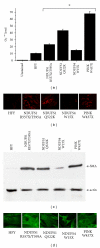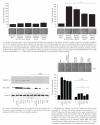Mitochondrial Oxidative Stress due to Complex I Dysfunction Promotes Fibroblast Activation and Melanoma Cell Invasiveness
- PMID: 22272371
- PMCID: PMC3261495
- DOI: 10.1155/2012/684592
Mitochondrial Oxidative Stress due to Complex I Dysfunction Promotes Fibroblast Activation and Melanoma Cell Invasiveness
Abstract
Increased ROS (cellular reactive oxygen species) are characteristic of both fibrosis and tumour development. ROS induce the trans-differentiation to myofibroblasts, the activated form of fibroblasts able to promote cancer progression. Here, we report the role of ROS produced in response to dysfunctions of mitochondrial complex I, in fibroblast activation and in tumour progression. We studied human fibroblasts with mitochondrial dysfunctions of complex I, leading to hyperproduction of ROS. We demonstrated that ROS level produced by the mutated fibroblasts correlates with their activation. The increase of ROS in these cells provides a greater ability to remodel the extracellular matrix leading to an increased motility and invasiveness. Furthermore, we evidentiated that in hypoxic conditions these fibroblasts cause HIF-1α stabilization and promote a proinvasive phenotype of human melanoma cells through secretion of cytokines. These data suggest a possible role of deregulated mitochondrial ROS production in fibrosis evolution as well as in cancer progression and invasion.
Figures





Similar articles
-
HIF-1α stabilization by mitochondrial ROS promotes Met-dependent invasive growth and vasculogenic mimicry in melanoma cells.Free Radic Biol Med. 2011 Aug 15;51(4):893-904. doi: 10.1016/j.freeradbiomed.2011.05.042. Epub 2011 Jun 12. Free Radic Biol Med. 2011. PMID: 21703345
-
Radiation-Induced Myofibroblasts Promote Tumor Growth via Mitochondrial ROS-Activated TGFβ Signaling.Mol Cancer Res. 2018 Nov;16(11):1676-1686. doi: 10.1158/1541-7786.MCR-18-0321. Epub 2018 Jul 24. Mol Cancer Res. 2018. PMID: 30042177
-
Regulation of mitochondrial oxidative stress by β-arrestins in cultured human cardiac fibroblasts.Dis Model Mech. 2015 Dec;8(12):1579-89. doi: 10.1242/dmm.019968. Epub 2015 Oct 8. Dis Model Mech. 2015. PMID: 26449263 Free PMC article.
-
Tumor microenvironment and metabolic synergy in breast cancers: critical importance of mitochondrial fuels and function.Semin Oncol. 2014 Apr;41(2):195-216. doi: 10.1053/j.seminoncol.2014.03.002. Epub 2014 Mar 5. Semin Oncol. 2014. PMID: 24787293 Review.
-
Myofibroblast differentiation during fibrosis: role of NAD(P)H oxidases.Kidney Int. 2011 May;79(9):944-56. doi: 10.1038/ki.2010.516. Epub 2011 Feb 9. Kidney Int. 2011. PMID: 21307839 Free PMC article. Review.
Cited by
-
Pronounced cancer resistance in a subterranean rodent, the blind mole-rat, Spalax: in vivo and in vitro evidence.BMC Biol. 2013 Aug 9;11:91. doi: 10.1186/1741-7007-11-91. BMC Biol. 2013. PMID: 23937926 Free PMC article.
-
Advances in the Pathogenesis of Adhesion Development: The Role of Oxidative Stress.Reprod Sci. 2014 Jul;21(7):823-836. doi: 10.1177/1933719114522550. Epub 2014 Feb 11. Reprod Sci. 2014. PMID: 24520085 Free PMC article. Review.
-
Loss of p16INK4A stimulates aberrant mitochondrial biogenesis through a CDK4/Rb-independent pathway.Oncotarget. 2017 Aug 3;8(34):55848-55862. doi: 10.18632/oncotarget.19862. eCollection 2017 Aug 22. Oncotarget. 2017. PMID: 28915557 Free PMC article.
-
AMPK signaling inhibits the differentiation of myofibroblasts: impact on age-related tissue fibrosis and degeneration.Biogerontology. 2024 Feb;25(1):83-106. doi: 10.1007/s10522-023-10072-9. Epub 2023 Nov 2. Biogerontology. 2024. PMID: 37917219 Free PMC article. Review.
-
The redox biology network in cancer pathophysiology and therapeutics.Redox Biol. 2015 Aug;5:347-357. doi: 10.1016/j.redox.2015.06.014. Epub 2015 Jun 25. Redox Biol. 2015. PMID: 26122399 Free PMC article. Review.
References
-
- Ishikawa K, Takenaga K, Akimoto M, et al. ROS-generating mitochondrial DNA mutations can regulate tumor cell metastasis. Science. 2008;320(5876):661–664. - PubMed
-
- Kalluri R, Zeisberg M. Fibroblasts in cancer. Nature Reviews Cancer. 2006;6(5):392–401. - PubMed
-
- Hinz B. Formation and function of the myofibroblast during tissue repair. Journal of Investigative Dermatology. 2007;127(3):526–537. - PubMed
-
- Gabbiani G, Ryan GB, Majno G. Presence of modified fibroblasts in granulation tissue and their possible role in wound contraction. Experientia. 1971;27(5):549–550. - PubMed
LinkOut - more resources
Full Text Sources

